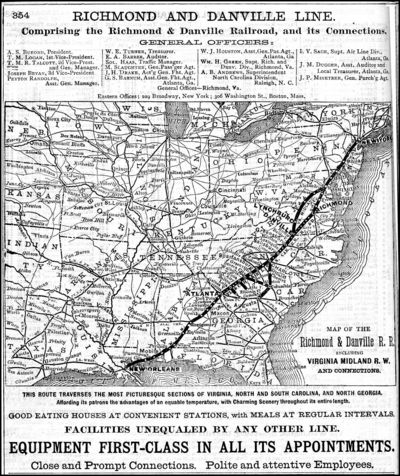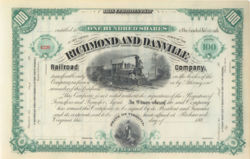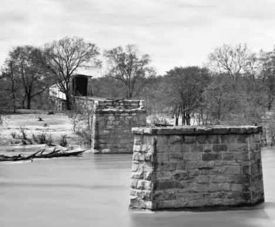Richmond and Danville Railroad

The Richmond and Danville Railroad was chartered in Virginia in the United States in 1847. The portion between Richmond and Danville, Virginia was completed in 1856. The railroad was only 140 miles long during the American Civil War but it played a vital role in linking Richmond to the rest of the Confederacy.
After the war, it grew to become the Richmond and Danville Railroad System, eventually covering 3,300 miles (5,300 km) in 9 states. In 1894, the R&D became part of the Southern Railway Company. In 1980, it became part of today's Norfolk Southern Railway.
Contents
History
The new railroad was championed by Whitmell P. Tunstall, a lawyer in Chatham, Virginia who was also a member of the Virginia General Assembly. Construction on the 140-mile (225 km) long line began in 1849 under the supervision of Col. Andrew Talcott, who was later to become the R&D's general manager. By 1850, the new railroad had reached Coalfield Station, near the coal mines in an area known today as Midlothian in western Chesterfield County. There, it competed with the mule-powered Chesterfield Railroad. Lawsuits followed, but the older railroad, the first in Virginia, was quickly supplanted by the competition.
By the end of 1851, the new line had reached Jetersville in Amelia County. Two years later, it was completed to a point near Drakes Branch, and had been graded to South Boston in Halifax County.
Serving in the US Civil War
Known as the "first railroad war," the American Civil War (1861-1865) left the South's railroads and economy devastated. In 1862, the Richmond and York River Railroad played a crucial role in George McClellan's Peninsula Campaign. After the war, it was to be acquired by the Richmond and Danville Railroad.
The Richmond and Danville Railroad was an essential transportation link for the Confederacy throughout the war. It provided the production of south-central Virginia to Richmond. When the Richmond and Petersburg Railroad was cut in 1864, the R&D's connection with the Piedmont Railroad was the only remaining connection from Richmond to the rest of the South.
During the Civil War, the Confederate Army was handicapped by a lack of supplies when there often were plenty of supplies in the depots, but the quartermaster corps of the southern army was unable to deliver the goods efficiently. In once case, however, the war finally forced the states-rights Confederate government to over-rule objections by North Carolina. That state had blocked construction of a rail connection from Greensboro to Danville, fearing that after the war trade from North Carolina's Piedmont would continue to flow to Richmond via the R&D.
Following successful Union attacks on April 1, 1865, Confederate Gen. Robert E. Lee decided to abandon Petersburg and head west and south in an attempt to join Gen. Joseph Johnston's army in North Carolina.
After evacuating Richmond the next day, on April 2, 1865, Confederate President Jefferson Davis and his cabinet left Richmond on the R&D. The departing Confederates set fire to the bridge across the James River between Richmond and Manchester. They traveled to Danville, where they attempted to set up a temporary government.
On reaching Amelia Courthouse during the morning of April 4, 1865, Lee's first thought was for the commissary stores. He found ordnance supplies in abundance, but no food. Lee waited 24 hours in vain there for R&D trains to arrive with badly needed supplies. Union cavalry, meanwhile, sped forward and cut the Richmond & Danville at Jetersville. Lee had to abandon the railroad, and his army stumbled across rolling country towards Lynchburg. On the morning of April 9, 1865, "Palm Sunday", Lee met Grant in the front parlor of Wilmer McLean's home near Appomattox Courthouse to surrender.
Reconstruction, Richmond & Danville Railroad System (1865-1894)
Buford builds the R&D System 1865-1892
With the support of Virginia Governor Francis H. Pierpont, on September 13, 1865, Algernon S. Buford became president of the 140-mile Richmond and Danville Railroad (R&D). Damage from the war, including the bridge across the James River between Manchester and Richmond was repaired.
Over the next 20 years, as R&D President, Buford and leaders including Richmonder James H. Dooley extended the trackage to three thousand miles. The R&D's early acquisitions included the Piedmont Railroad in 1866, and the North Carolina Railroad in 1871.
By 1890, the R&D System covered 3,300 miles of track in Virginia, North Carolina, South Carolina, Georgia, Tennessee, Alabama, Mississippi, Arkansas, and Texas. However, the R&D System had become financially unstable during all the growth.
Southern Railway System 1894; Norfolk Southern 1982
In 1892, the R&D and subsidiaries entered receivership. Reorganized by J.P. Morgan and his New York banking firm of Drexel, Morgan and Company, they emerged in 1894 as the Southern Railway Company, which controlled over 4,000 miles of line at its inception. Samuel Spencer became Southern's first president.
In 1980, the Southern Railway became part of today's Norfolk Southern Railway.
References
- Burke Davis (1985) The Southern Railway: Road Of The Innovators Chapel Hill, N.C.: University of North Carolina Press
- Historic Railroad Maps commercial site
- Confederate Railroads website
- Dan River Tour website
- Georgia's Railroad History & Heritage website
- Special Collections, Virginia Tech University Library
- Civil War Richmond
- College of William and Mary, Railroads in Antebellum Richmond
- Virginia Places, Sectional Rivalry page
- Lee's Retreat - A Driving Tour
- An Abbreviated History of Pittsylvania County, Virginia - Transportation and Routes
- US Civil War, Appomattox Campaign
- History of Western North Carolina - Railroads
- The Stranger's Guide and Official Directory for the City of Richmond Electronic Edition
- Iron Confederacies Timeline
External links
- Historic Railroad Maps commercial site
- Confederate Railroads website
- Dan River Tour website
- Georgia's Railroad History & Heritage website
- Special Collections, Virginia Tech University Library
- Civil War Richmond
- College of William and Mary, Railroads in Antebellum Richmond
- Virginia Places, Sectional Rivalry page
- Lee's Retreat - A Driving Tour
- An Abbreviated History of Pittsylvania County, Virginia - Transportation and Routes
- US Civil War, Appomattox Campaign
- History of Western North Carolina - Railroads
- The Stranger's Guide and Official Directory for the City of Richmond Electronic Edition
- Iron Confederacies Timeline
- Southern Railway Historical Association
- Norfolk Southern Corporation official website
- Virginia Museum of Transportation displays famous N & W steam locomotives, located in Roanoke, VA
- Southern Railway Yahoo Group a Yahoo group for former employees, railfans and modelers of the Southern Railway
- Norfolk Southern Yahoo Group a Yahoo group for current happenings of Norfolk Southern Railway


